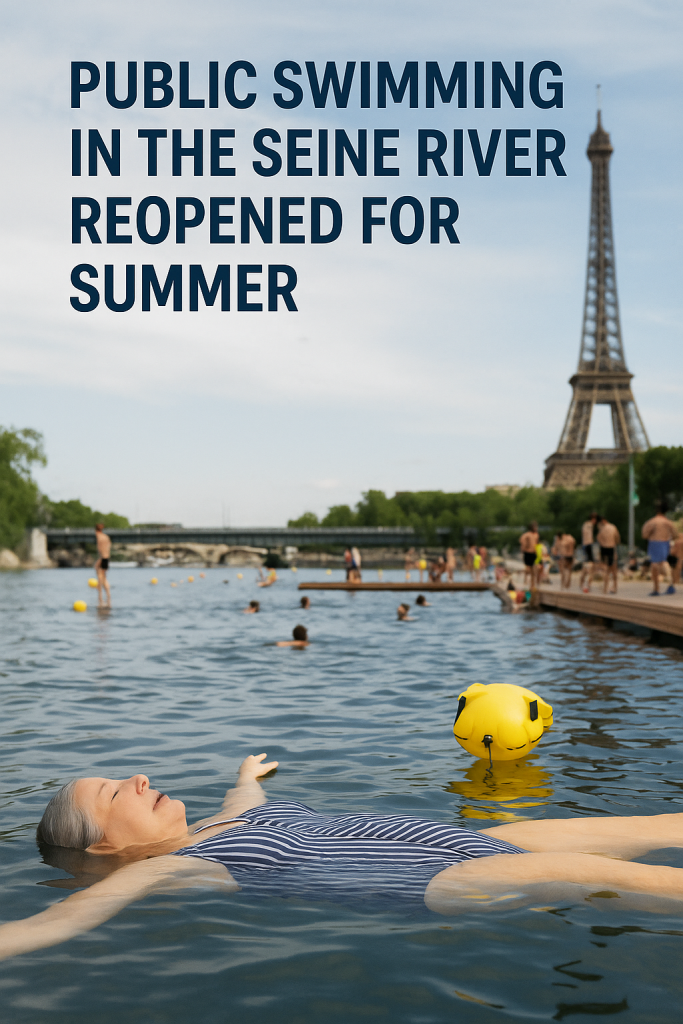Paris has officially reopened the Seine River to public swimming this summer, welcoming both locals and tourists to plunge into its iconic waters after an extensive environmental restoration. This exciting development comes as part of the city’s comprehensive efforts to revitalize the Seine in the lead-up to the 2024 Olympic Games, transforming the river from a historically polluted waterway into a clean and safe aquatic playground.
The decision to allow public swimming in the Seine marks a milestone in urban environmental management and Olympic legacy planning. For decades, swimming in the Seine had been off-limits due to water quality concerns, but a series of ambitious infrastructure upgrades and rigorous water treatment initiatives have dramatically improved the river’s health. Recent water quality tests confirm that the Seine now meets stringent safety standards, making it suitable for recreational use and a symbol of Paris’s commitment to sustainable urban life.
Transforming the Seine: From Polluted Past to Olympic-Ready
The push to clean up the Seine is part of a broader environmental mission initiated years ago, intensified by the upcoming global spotlight from the 2024 Summer Olympics. Authorities have invested heavily in advanced sewage treatment plants, stormwater management systems, and pollution control measures to reduce contaminants entering the river. These efforts have substantially lowered bacteria levels and improved the overall ecology of the Seine basin.
Beyond purely technical interventions, the project included dredging to remove harmful sediments and restructuring riverbanks to promote biodiversity. This not only improved water clarity and safety but also enhanced the river’s aesthetic and recreational appeal—key for an event like the Olympics, which emphasizes environmental stewardship and green urban experiences.
Opening the Seine to swimmers is more than just a summer leisure option—it’s a powerful statement about Paris’s environmental progress and vision.
Swimming Spots and Safety Measures
The public swimming areas are located in designated zones along the river, equipped with safety stations, lifeguards, and hygiene facilities to ensure a secure and enjoyable experience. Signage clearly marks swimming boundaries, and periodic water quality monitoring is in place to quickly detect and respond to any issues.
Event organizers and city officials have also introduced educational campaigns to raise awareness about river ecology and responsible behavior, encouraging swimmers to enjoy the Seine sustainably. These measures aim to balance public access with environmental preservation.
The Seine Experience: A Unique Summer Attraction
Visitors can now savor a rare opportunity to swim through the heart of Paris, passing historic landmarks like the Île de la Cité, Notre-Dame Cathedral, and the Eiffel Tower, all while immersed in the Seine’s revitalized waters. This new recreational offering complements the city’s bustling parks and pools, adding a unique urban water experience that enhances Paris’s global reputation as a vibrant, forward-thinking metropolis.
As the world gears up for the 2024 Olympics, the reopening of the Seine River for swimming illustrates how sporting events can drive positive, lasting environmental change. For Parisians and travelers alike, this summer promises not only thrilling competitions but also the chance to reconnect with the city’s most storied river in a truly refreshing way.
Looking Ahead
Following the 2024 Olympics, city planners have committed to maintaining the Seine’s water quality and sustaining the public swimming program as a permanent fixture. This long-term vision supports Paris’s goals of expanding green public spaces, promoting active lifestyles, and demonstrating how urban waterways can serve as safe, accessible recreation hubs.
In summary, the Seine’s reopening to swimmers this summer embodies a remarkable environmental turnaround and offers a new way to experience Paris. It stands as a testament to the power of coordinated urban renewal efforts and the promising legacy



